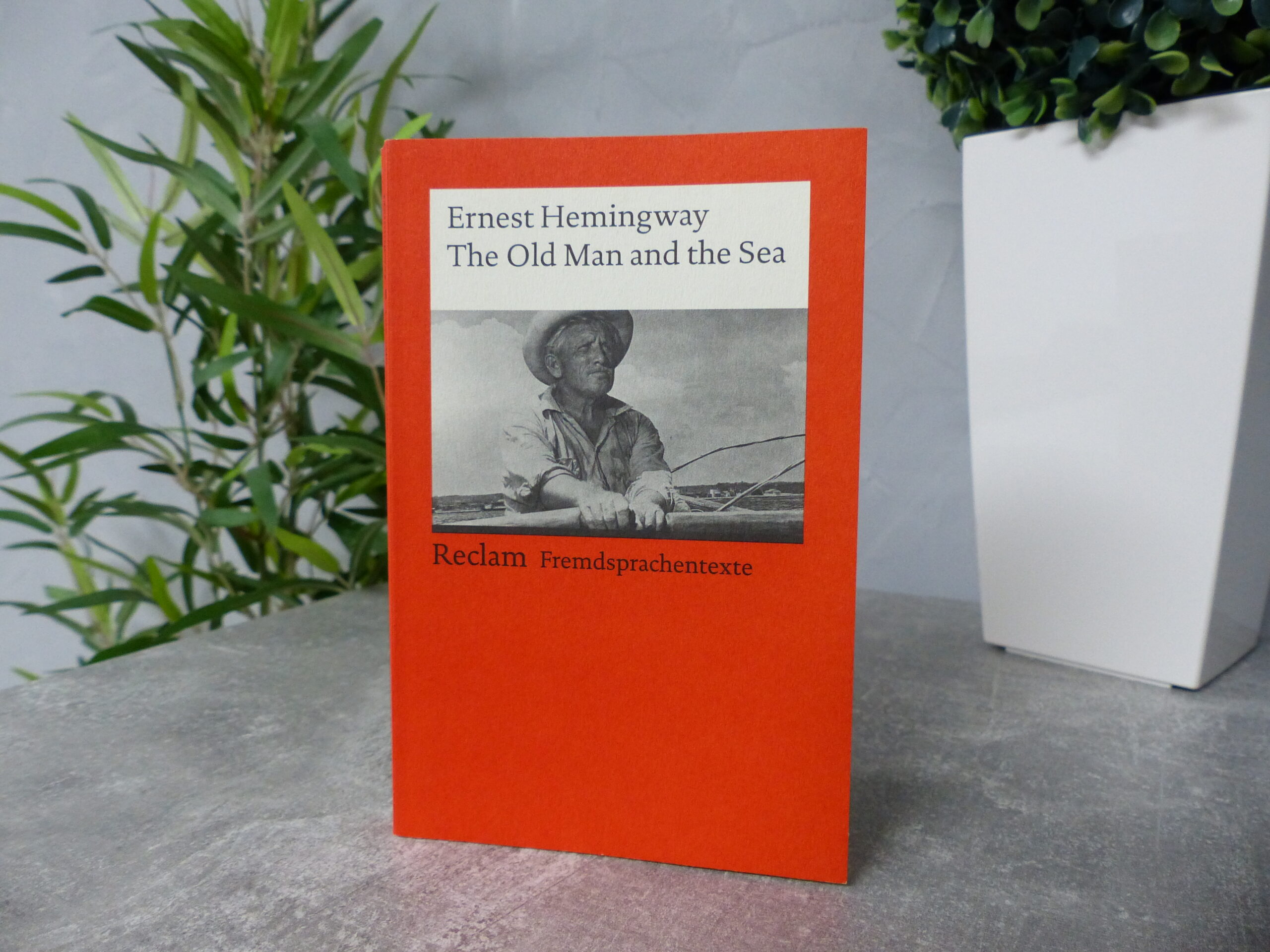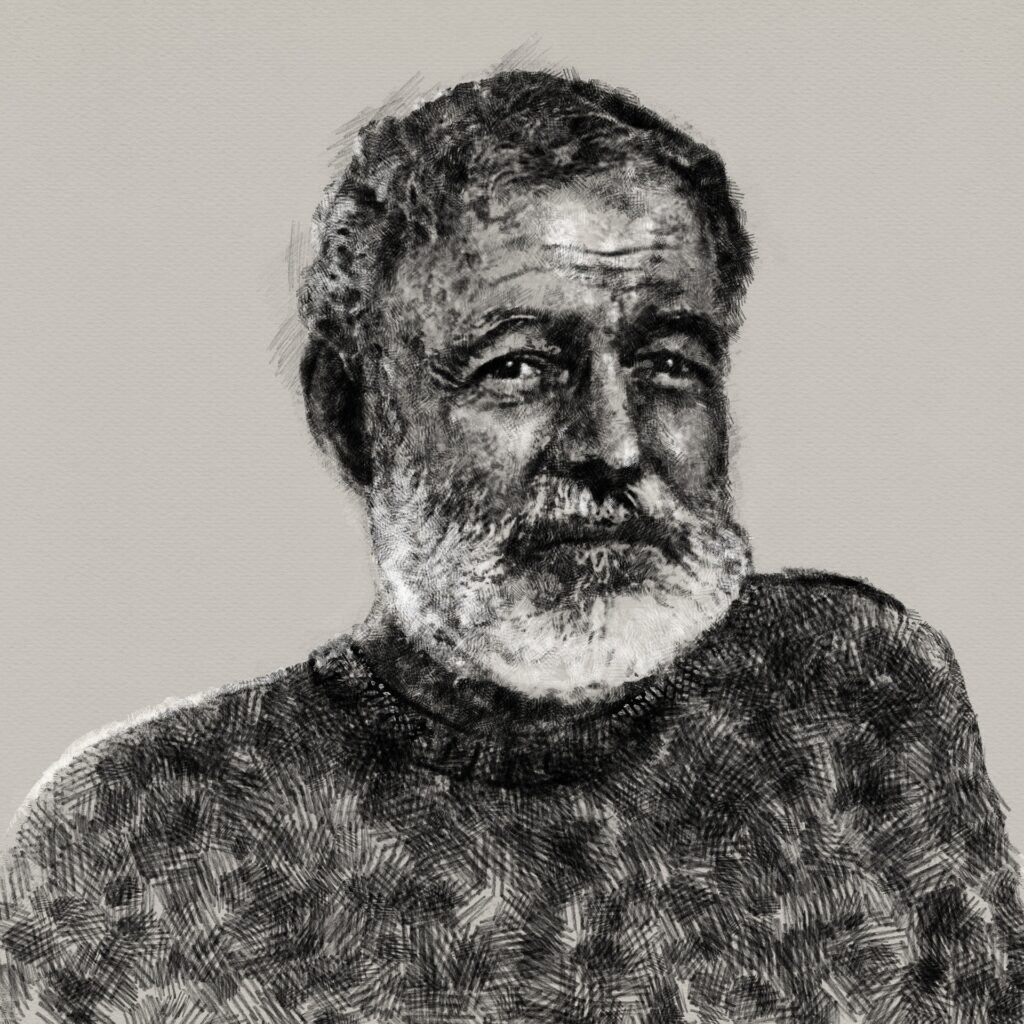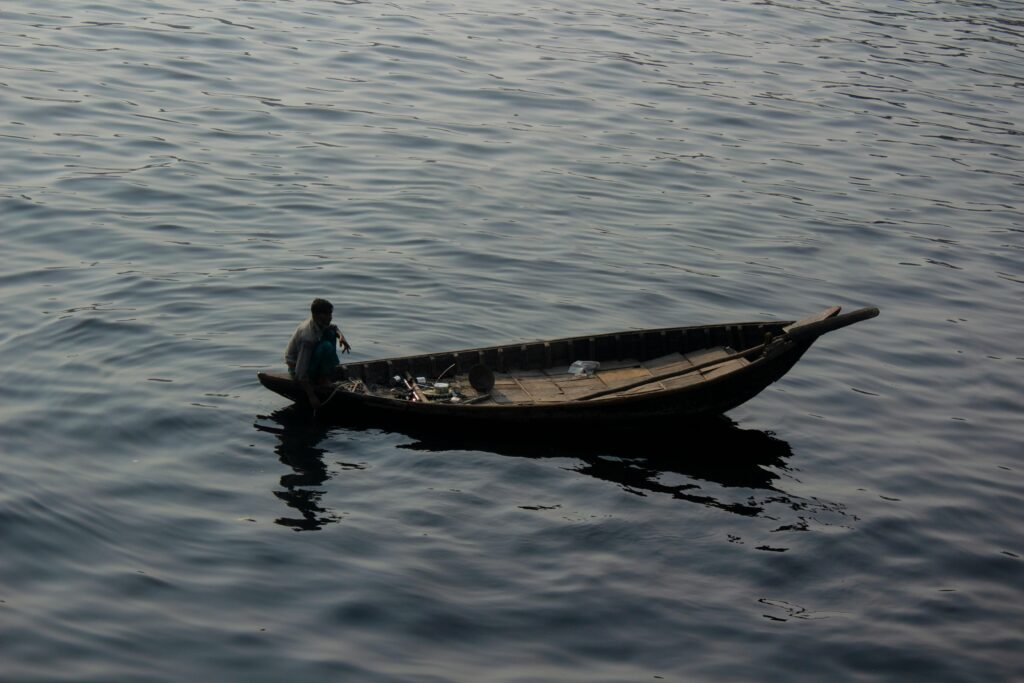
The Old Man and the Sea: A Classic Summary, Review, and Analysis
Ernest Hemingway is famously known for his exceptional way of writing and dealing with complex topics. He published The Old Man and the Sea back in 1952, which is usually considered one of his best. After the novella was written in Cuba, where Hemingway spend most of his time fishing, it reflected his love for the sea and the art of fishing.
Being affected by his adventures and the local fishermen he met, Hemingway was able to compose a story that captures the struggle between man and nature. This story not only shows his literary skills but also the human ability to endure the hardships of life.
Plot Summary: The Tale of Santiago and His Great Struggle
An Old Man, a Boy, and a Dream
The story revolves around Santiago, an old Cuban fisherman. He is very experienced and a great fisherman, yet he has not caught a single fish for 84 days. Nevertheless, his spirit remains unbroken and he does not let this affect him.
He lives a simple life, living alone in a small shack, using paper-stuffed pants as a pillow and sailing on a beat-up tiny skiff. But his heart is rich with contentment, wisdom and a deep connection to the sea.
To redeem himself and finally catch a fish again, he plans on sailing out further than usual. The night before setting off to sea, Santiago dreams once again of the lions, a symbol of his youthful strength and enduring hope.
Manolin, a young boy, shares a special bond with Santiago, from whom he learned how to fish. He sailed together with the old man for years, but now his parents have forbidden him from fishing with Santiago due to his streak of bad luck. Nevertheless, Manolin’s loyalty never wavers. He cares for Santiago, helps him with supplies, and even brings him food. Their relationship is a poignant depiction of mentorship, love, and the respect shared across generations.
The Journey Out to Sea
As dawn breaks, Santiago sets out alone in his skiff (a very small boat), rowing farther into the Gulf Stream than he has in years. The sea, in his eyes, is both beautiful and cruel—a nurturing yet unpredictable force. Unlike younger fishermen who view it as an enemy to be conquered, Santiago respects the sea as a partner in his craft.
Skillfully reading the signs of the ocean, he casts his lines and patiently waits, savoring the beauty around him. He catches a small tuna to use as bait and marvels at the graceful movements of dolphins and delicate birds. Farther out than he planned, Santiago remains steadfast, trusting his meticulous preparation and patience to yield results.
The Struggle with the Marlin
Santiago’s struggle with the marlin is one of great pain, endurance and sheer willpower. From the moment the fish takes the bait, Santiago knows that this is a great fish. A worthy opponent. The marlin is so huge and so strong, that it begins to pull the small skiff further into the open sea.
Santiago holds the line around his back and with his bare hands, getting cut every second. The fight goes on for three days. Both are struggling with hunger, sleep deprivation and permanent pain. Yet both endure. Both are determined to overcome.
Despite this fight and the constant pain, Santiago sees the marlin not as a foe, but as a brother. He describes the fish as a noble creature, which he respects deeply for its power and dignity.
On the third day, Santiago is finally able to kill the marlin with his harpoon. In a last attempt, the marlin jumps out of the water. The moment is truly majestic. Time stops. Hemingway beautifully describes how the magnificent fish flies through the air for just a few seconds, yet it feels like forever.
The Sharks Attack
Santiago’s struggle with the marlin turns tragic when the fish begins to bleed, discoloring the water. After securing the 1,500-pound, 18 feet marlin to his skiff, he faces a beautiful mako shark that attacks. Although he kills the shark with a harpoon, it swims away, foreshadowing more challenges. Santiago feels pity for the marlin, which he sees as “mutilated,” and despite losing 40 pounds of the fish to the shark, he finds solace in being able to travel lighter.
As more sharks appear, Santiago fights to defend his catch, killing a shovel-nosed shark but feeling the loss as they scavenge a quarter of the marlin. When a pack of sharks descends on his catch at midnight, he realizes he has been defeated as they consume the remains. Indifferent to the additional sharks, Santiago acknowledges that little is left of the marlin and holds himself accountable for sailing too far out to sea.
The Return and Reflection
Late at night, Santiago arrives back in his village. He secures his boat and the remains of the marlin, then drags himself to his shack, collapsing into bed. By morning, Manolin visits and is moved to tears upon seeing the old man’s injuries and the stripped-down marlin. Despite Santiago’s belief that he has been defeated, Manolin reassures him that his efforts prove his greatness. Inspired, the boy declares he will fish with Santiago again, regardless of his parents’ wishes.
As tourists admire the marlin’s skeleton, mistaking it for a shark, Santiago rests, dreaming once more of the lions on the African beaches. The dream symbolizes his undying spirit and the enduring hope of his youth that life’s struggles, no matter how challenging, are worth the effort.

Analysis: Hemingway’s Lessons
In The Old Man and the Sea, Hemingway uses the experience of an old man, who has seen it all, to show the reader what a man should be like. He teaches us what truly matters in life and how we must behave.
Humility
Humility is important because it reminds us that we are small compared to the vastness of life and nature. It keeps us grounded and helps us focus on what truly matters, rather than on pride or ego. Recognizing that we are just one part of something larger fosters gratitude and purpose.
Santiago embodies humility in how he sees himself. He does not think of himself as a great fisherman, even though he has extraordinary skill and experience. When Manolin calls him the best fisherman, Santiago denies it, showing that his actions matter more to him than titles or praise.
Through his humility, Santiago shows us that greatness is not about how others see us but about how we carry ourselves. Even in the face of incredible challenges, he stays humble, grounded, and focused on the task at hand.
Perseverance, Determination, Resilience
The ability to persist, remain determined, and bounce back from setbacks is fundamental for overcoming life’s adversities. These qualities help us to overcome obstacles and turn them into opportunities, reminding us that giving up should never be an option. Embracing perseverance enables us to reach for what we truly desire, no matter the hardships we face.
Santiago demonstrates these virtues in his relentless pursuit of the marlin. He endures days of physical and mental strain as he wrestles with the fish. Even when his hands are cut and his back aches, he doesn’t lose focus or give up on his goal.
His resilience is tested further when sharks attack the marlin he fought so hard to catch. Instead of surrendering, Santiago battles the sharks to defend what he has earned. His actions show us that true success comes from refusing to compromise, even in the face of overwhelming challenges.
Compassion, Respect, Reverence
These values guide us in maintaining integrity and connection, even in moments of difficulty, reminding us to treat others with dignity and kindness, regardless of the circumstances.
Santiago shows compassion and respect for the marlin, even though he knows he must kill it. He calls the marlin his brother and admires its strength, beauty, and courage. This deep reverence for his opponent demonstrates his respect for life, even when survival requires sacrifice.
Even when the marlin cuts Santiago’s hands and strains his body, he does not lose his respect for the creature. His actions remind us that it is possible to honor others—even those we struggle against—by seeing their worth and treating them with dignity.
Patience and Pragmatism
Cultivating patience and pragmatism equips us to navigate life’s unpredictability with composure and thoughtfulness. They inspire a focus on steady effort and resilience rather than succumbing to frustration or impatience. Embracing a pragmatic mindset empowers us to tackle challenges with clarity, ensuring we remain grounded in our pursuits.
Santiago is a master of patience. He waits for days to catch the marlin, never losing faith in his efforts. He doesn’t waste energy on frustration or anger, knowing that success requires both time and steady effort.
His pragmatism is evident in how he handles every challenge. He plans each action carefully, conserving his strength and remaining focused on what he can control. Through his patience and practicality, Santiago teaches us the value of staying calm and persistent, even when the odds seem stacked against us.
Attentiveness, Composure, Accountability
These qualities anchor us in the present moment, fostering a sense of responsibility for our actions and their impact. Without them, we risk losing sight of our goals, acting rashly, or shifting blame onto others instead of confronting our own shortcomings.
Santiago’s attentiveness is seen in how he observes the world around him. He notices the beauty of the sea, the stars, and the marlin itself, even in the middle of his struggle. His ability to find beauty amid hardship reflects a deep mindfulness and appreciation for life.
His composure and accountability shine through when things go wrong. When sharks attack the marlin, he doesn’t blame them or the sea; instead, he blames himself for sailing too far out. Santiago takes responsibility for his choices, showing that true strength comes from owning our actions and their consequences.
A Negative Example: The Tourist Woman
At the end of the book, the tourist woman offers a clear example of what not to do. She sees the white, skeletonized spine of the marlin and asks the waiter what fish it was. The waiter begins to explain, but she cuts him off after hearing just “Eshark.”
She doesn’t care enough to listen further or understand what really happened. Instead, she says, “I didn’t know sharks had such handsome, beautifully formed tails.” She ignores the incredible effort and struggles Santiago endured to catch the marlin and defend it. This thoughtlessness highlights the importance of being mindful and attentive to the struggles of others.
Hemingway contrasts the tourist woman with Santiago to teach us an important lesson. While Santiago’s virtues allow him to face life with strength and meaning, the tourist woman’s lack of depth leaves her blind to the beauty and struggles around her.
The Reader’s Takeaway
Don’t be like the tourist woman. Don’t take things at plain value. Be like Santiago.
Be mindful, think for yourself, and don’t compromise your values. Strive for what is important, and don’t let anyone stop you. Hemingway’s story teaches us that it’s not the results that matter most, but how we live and face life’s challenges.

Review: My Thoughts on The Old Man and the Sea
Hemingway’s The Old Man and the Sea is a masterpiece characterized by its simplicity and profound depth. Beneath its surface, the novel delves into themes of human strength, humility, and perseverance. Here’s why I believe this work stands out as a timeless classic.
A Tale That Rewards the Mindful Reader
At first glance, the narrative may seem uneventful: an old man goes fihsing, starts as a nobody, and returns with a fish carcass. For the inattentive reader—the “tourists of the world”—this could render the book borderline boring.
However, for the mindful reader—the “Santiagos of the world”—the story is rich and engaging. Each detail of Santiago’s thoughts, behaviors, and actions reveals profound wisdom. Hemingway utilizes the story’s of the old man to explain essential life lessons, making it a rewarding experience for those who engage with the narrative on a deeper level.
Immersive Writing That Puts You Beside Santiago
One of the elements I found most captivating about the book was Hemingway’s writing style. His vivid descriptions transport you directly into Santiago’s world. Whether it’s the tug of the fishing line, the strain in his back, or the vastness of the sea, the prose immerses you in the experience, almost placing you beside him in the small skiff.
Hemingway also conveys Santiago’s extensive knowledge with remarkable clarity. Through his observations and insights, we understand how connected he is with nature and the behavior of the fish.
A Teaching Story
I appreciate reading stories are not just interesting but which convey important lessons at the same time, and The Old Man and the Sea excels in this regard. Hemingway not only entertains but also inspires. Through Santiago’s journey, he illustrates what it means to embody patience, perseverance, humility, and respect. Santiago shows what a man should be.
Santiago’s portrayal demonstrates how to confront life’s challenges with dignity and resilience. His journey reveals that success lies not solely in the outcome but in the effort and the work put in.
A Story That Stays with You
In the end, The Old Man and the Sea is much more than a simple story about fishing. It explores important ideas about life and the challenges we all face. Hemingway encourages the reader to look deeper and find meaning in both Santiago’s journey as well as in their own life.
For me, this book is a great example of storytelling that really matters. It’s a story that resonates and stays with you long after you finish reading it. If you approach it with the same thoughtfulness as Santiago, it will inspire and enrich you.
Conclusion
The Old Man and the Sea is not just about an old man and his struggle with a fish; it highlights the important qualities that make us human. Hemingway shows that true success isn’t about trophies or what others think, but about how we handle life’s challenges with determination and integrity.
Through Santiago, we learn what it means to live with purpose and respect for ourselves and others. His journey teaches us that real greatness comes from the effort we put in and how we keep going despite difficulties.
Hemingway’s story reminds us to face life like Santiago—with courage and thoughtfulness. It’s an inspiring tale that offers valuable lessons for anyone willing to explore its meaning.
Be like Santiago, not like the tourists. Don’t take anything at face value, look deeper.
Rating
Relevance and Practicality: 9/10
The lessons in The Old Man and the Sea—how a man should behave—are timeless and deeply relevant, particularly in today’s world. Santiago’s virtues serve as a blueprint for living with purpose and integrity. In an age often driven by superficiality and quick gratification, this story’s emphasis on enduring struggle, staying true to one’s principles, and looking for the deeper meaning in life, feels especially important.
Clarity and Readability: 9/10
Hemingway’s writing is straightforward and easy to understand, but the frequent use of fishing terminology might be a challenge for readers who aren’t familiar with the fishing world. The book also requires careful reading to uncover the important lessons hidden within the story. Skimming through would reduce the narrative to a simple tale, missing its deeper exploration of life and character. When you take the time to look closely, the language is truly beautiful.
Content Depth: 10/10
The depth of this book is impressive. Hemingway balances detailed descriptions of Santiago’s surroundings, like the sea and the fish, with insights into his internal struggles and thoughts. This combination draws readers into Santiago’s world, making the story immersive and emotionally engaging. The mix of external events and internal reflections creates a valuable source of life lessons and thoughts on human strength.
FAQs
The prose is simple, but understanding its deeper lessons requires careful reading.
The lions symbolize Santiago’s youth, strength, and enduring hope.
No, it’s a metaphor for life’s struggles and the virtues needed to face them.
Anyone who values reflective stories with meaningful lessons.
Resilience, humility, and respect define true success in life.
Further Reading and Resources
Explore More on Our Blog – Related Articles You Will Like!
Recommended External Resources
https://www.britannica.com/topic/The-Old-Man-and-the-Sea-novel-by-Hemingway